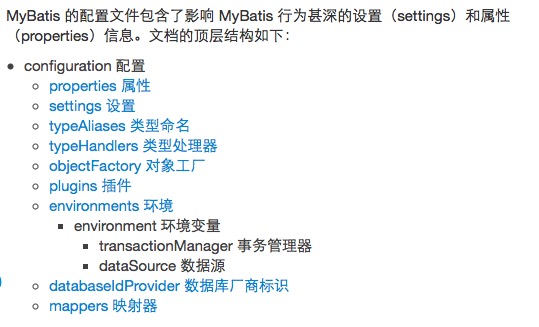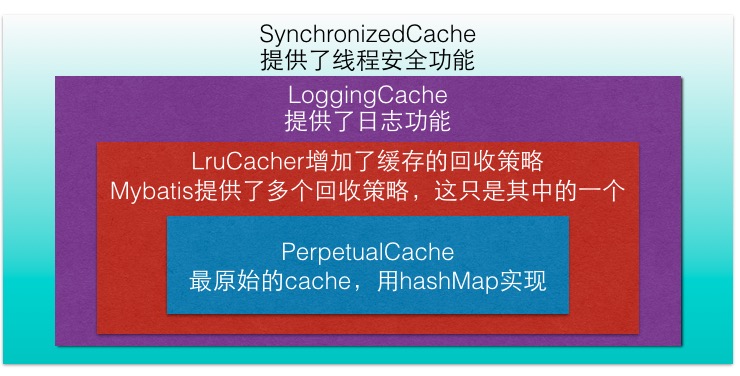版权声明:本文为博主原创文章,未经博主允许不得转载。 https://blog.csdn.net/ashan_li/article/details/50357235
Configuration中的配置信息
下图是官方文档中对Configuration的介绍

这里xml配置是由两个对象加载Configuration对象中
- XMLConfigBuilder。这个对象负责加载除mappers映射器之外的所有配置。
- XMLMapperBuilder。这个对象只负责加载mappers映射器中的配置。其中他还有个助手:MapperBuilderAssisant。XMLMapperBuilder与MapperBuilderAssisant有明确的分工。
XMLConfigBuilder加载配置
这个加载过程比较简单,主要是读取配置,再创建对象,最后把对象加入Configruation中。而创建对象主要有两方式:
- 通过类名加载对象。
- 从配置中加载类名或类的别名
- 通过类名实例化对象
- 设置对象属性
- 将对象加入Configuration中
//解析对象工厂 private void objectFactoryElement(XNode context) throws Exception { if (context != null) { //从配置中读取类名 String type = context.getStringAttribute("type"); //从配置中读取改造 Properties properties = context.getChildrenAsProperties(); //根据类名创建对象 ObjectFactory factory = (ObjectFactory) resolveClass(type).newInstance(); //设置对象属性 factory.setProperties(properties); //加入到Configuration中 configuration.setObjectFactory(factory); } } - 通过配置的内容(字符串)加载对象。这种对象一般都结构简单的,如枚举类型,Boolean类型等.
- 读取配置的字符串内容
- 调用valueOf方法得一个对象
configuration.setAutoMappingBehavior(AutoMappingBehavior.valueOf(props.getProperty("autoMappingBehavior", "PARTIAL")));
XMLMapperBuilder加载配置
XMLMapperBuilder主要加载如下三个配置,其他的比较少用。
- cache
- resultMap
- select/update/insert/delete
XMLMapperBuillder的助手XMLMapperAssiant
一个XMLMapperBuilder就会有一个助手。两个对象有明确的分工。XMLMapperBuilder对象负责从XML读取配置,而他的助手负责创建对象并加载到Configuration中。例如:
private ResultMapping buildResultMappingFromContext(XNode context, Class<?> resultType, ArrayList<ResultFlag> flags) throws Exception {
//XMLapperBuilder负责从xml读取配置
String property = context.getStringAttribute("property");
String column = context.getStringAttribute("column");
String javaType = context.getStringAttribute("javaType");
String jdbcType = context.getStringAttribute("jdbcType");
String nestedSelect = context.getStringAttribute("select");
String nestedResultMap = context.getStringAttribute("resultMap",
processNestedResultMappings(context, Collections.<ResultMapping> emptyList()));
String notNullColumn = context.getStringAttribute("notNullColumn");
String columnPrefix = context.getStringAttribute("columnPrefix");
String typeHandler = context.getStringAttribute("typeHandler");
String resulSet = context.getStringAttribute("resultSet");
String foreignColumn = context.getStringAttribute("foreignColumn");
boolean lazy = "lazy".equals(context.getStringAttribute("fetchType", configuration.isLazyLoadingEnabled() ? "lazy" : "eager"));
Class<?> javaTypeClass = resolveClass(javaType);
@SuppressWarnings("unchecked")
Class<? extends TypeHandler<?>> typeHandlerClass = (Class<? extends TypeHandler<?>>) resolveClass(typeHandler);
JdbcType jdbcTypeEnum = resolveJdbcType(jdbcType);
//助手负责创建对象并加入Configuration
return builderAssistant.buildResultMapping(resultType, property, column, javaTypeClass, jdbcTypeEnum, nestedSelect, nestedResultMap, notNullColumn, columnPrefix, typeHandlerClass, flags, resulSet, foreignColumn, lazy);
}public ParameterMapping buildParameterMapping(
Class<?> parameterType,
String property,
Class<?> javaType,
JdbcType jdbcType,
String resultMap,
ParameterMode parameterMode,
Class<? extends TypeHandler<?>> typeHandler,
Integer numericScale) {
resultMap = applyCurrentNamespace(resultMap, true);
// Class parameterType = parameterMapBuilder.type();
Class<?> javaTypeClass = resolveParameterJavaType(parameterType, property, javaType, jdbcType);
TypeHandler<?> typeHandlerInstance = resolveTypeHandler(javaTypeClass, typeHandler);
//利用Builder来创建对象
ParameterMapping.Builder builder = new ParameterMapping.Builder(configuration, property, javaTypeClass);
builder.jdbcType(jdbcType);
builder.resultMapId(resultMap);
builder.mode(parameterMode);
builder.numericScale(numericScale);
builder.typeHandler(typeHandlerInstance);
return builder.build();
}Configuration中默认的Cache对象
Cache对象采用装饰模式实现,对PerpetualCache层层装饰,实现最终需要实现的功能

Configuration中的resultMaps属性

- 一个resultMap元素对应一个ResultMap对象
- resultMap元素中的idArg/id/result/association/collection元素对应一个ResultMapping对象,所有resultMap会有多个ResultMapping对象
- association/collection元素对应一个内映射的ResultMap
- 不管是ResultMap对应还是内映射的ResultMap对象都会被加入到Configuration.resultMaps属性
Configuration.mappedStatements属性
select/update/insert/detele元素会被解析成一个MappedStatement对象,这个对象有一个SqlSource属性,这个属性代表了sql具体的定义。SqlSource又由多个SqlNode组成,这个SqlNode是用组合模式实现的。BoundSql和SqlNode对象在以后分析sql执行时再讨论。